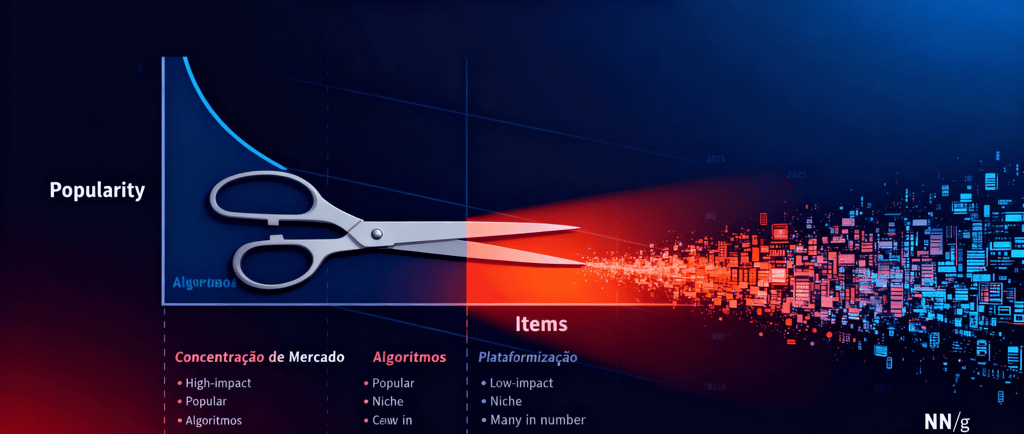IS THIS THE END OF THE LONG TAIL AS WE KNOW IT?
A discrete change in searches made by Google can really change the Internet we know
10/6/20253 min read


Quite quietly, Google just made a change that drastically changes the internet as we know it. To give you an idea, it affects practically 90% of the world's websites. For those unfamiliar, a fundamental foundation of the internet since its inception was the creation of the so-called "long tail." The long tail is the name given to the nearly infinite database of results for any search. I'll explain better by bringing it into the physical world...
In a traditional store, no matter how large, the challenge is to have enough of the 10, 20, or 30 best-selling products. Because they're the best sellers, the quantity sold is much greater than that of the others, and therefore, it's not just about having more stock, but also having enough stock. The greater the discrepancy between the top products and the others, the more complicated the equation becomes. Think of a single-brand sneaker store: you need to stock absurd quantities of the top models, top sizes, and three styles: men's, women's, and children's. If there are 20 models of each, that's 60 in total, multiplied by the most common numbers (let's assume 3 for each type), that is, 60 X 3 X 3 = 540. If each of them sells 10 units per month, we have 5,400 pairs (yes, that's right) in a month of just them. This is what we call the short tail—that is, we have a large volume of a few models that only leave room for a few units of other models. This is one of the reasons for the high cost of inventory. The basis is Pareto's Law: 10 or 20% of the items corresponds to 80 or 90% of the volume and/or revenue.
In a digital world, imagine this same store without needing inventory and being able to offer all the models it can afford. After some time, when looking at the sales chart, it will continue to see a concentration of many units of some models, which gradually decrease until it reaches near zero. This is the long tail. The more models, sizes, and versions sold, the longer the tail.
But what does this have to do with Google? Since the decline of Yahoo!, Google has become a sort of internet monopoly, accounting for 95% of all searches. Google's success has been in knowing how to organize these results, showing on the first page what interests 90% of users, but showing results on up to 100 pages? Because in these 100 pages, Google manages to deliver the interests of all users, not just the most popular ones. This is the long tail we use every day.
But it's not just us: AI tools use this too. Also, for those who don't know, Google search, because of its precision and importance, is the basis for training and research for AIs, and that's the crux of the matter. By reducing results to 10 pages, even if it shows more later, Google changes the search dynamics and makes it harder for AI robots to obtain results. In a world of quantity, quality can be measured by Pareto: 10% of results are of interest in 90% of searches. But what about in a world of specific, precise, tailored results? Let's say you use AI to search for a particular sneaker model that's very rare. In that case, 10 pages of results might not be enough.
What's behind all this is a turf battle: people increasingly tend to search for things using AI, to bring back more accurate and complete results. Even though Google automatically deploys AI, this doesn't actually train your searches. And there's already talk of GEO, which is the optimization and learning of searches using Generative AI, generating much more accurate and complete results, instead of a bunch of unwanted results lumped together just because they're popular. This, in itself, is the end of the long tail: Yahoo! already displayed the long tail, but the results were confusing at a time when the total number of options was increasing exponentially. Google first managed to better organize these results, using user behavior itself to prioritize (a qualitative criterion) and the site's relevance to the searched topic (a quantitative aspect). By charging companies to appear in search, he added a third pillar: the possibility of promoting new products and services to compete with those already on the market for a long time.
Without sponsored search, it would be difficult to launch a new product or brand and achieve rapid success. In any case, with the migration of search to AI tools, precisely because of the quality of the answers, Google is trying to make access more difficult, creating a logistical barrier.
Will this be enough? Probably not. But Google has shown that it doesn't mess around, and after a period of many failed attempts, the company seems to have found its way back with AI. You're watching history being made. Enjoy.
